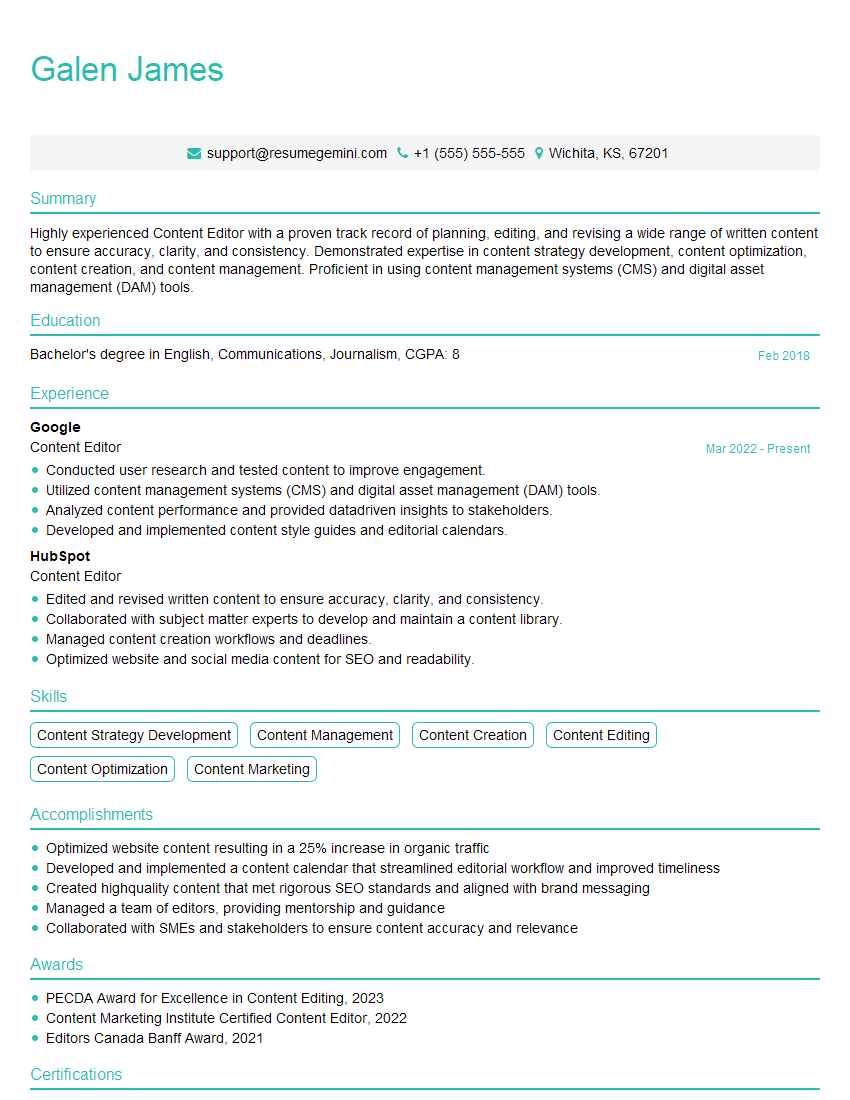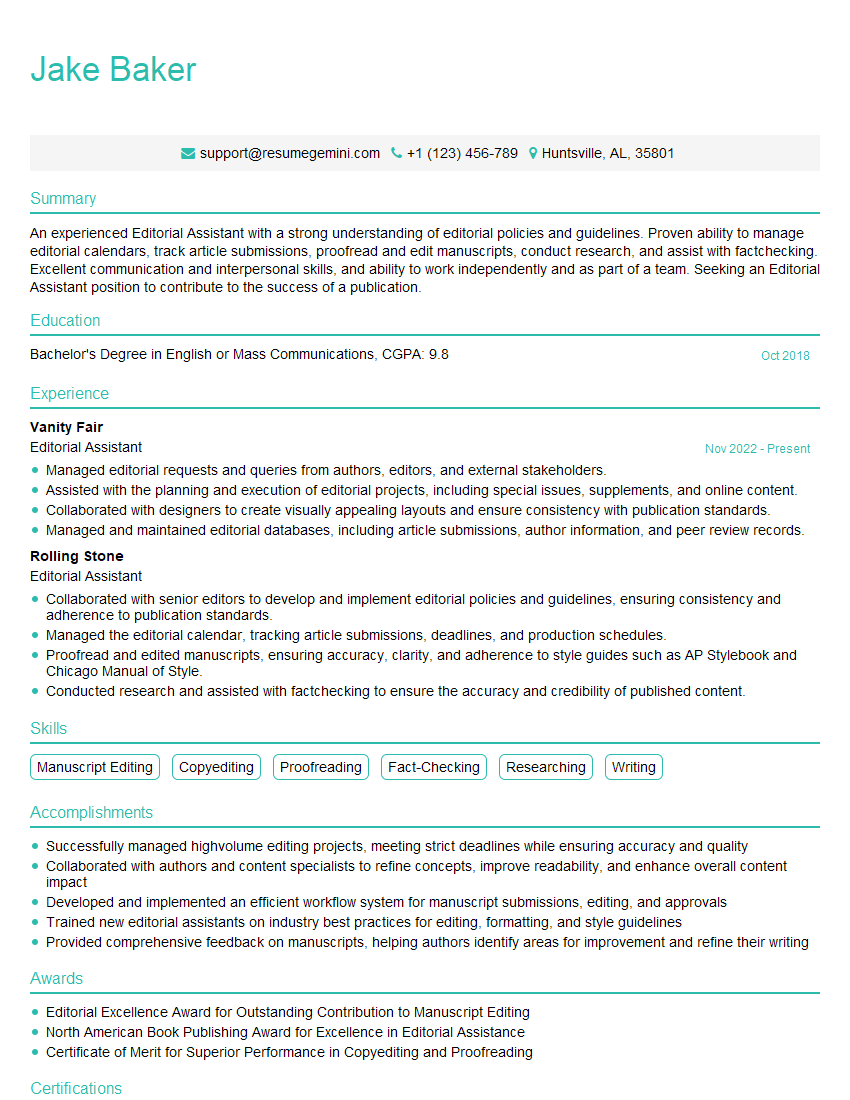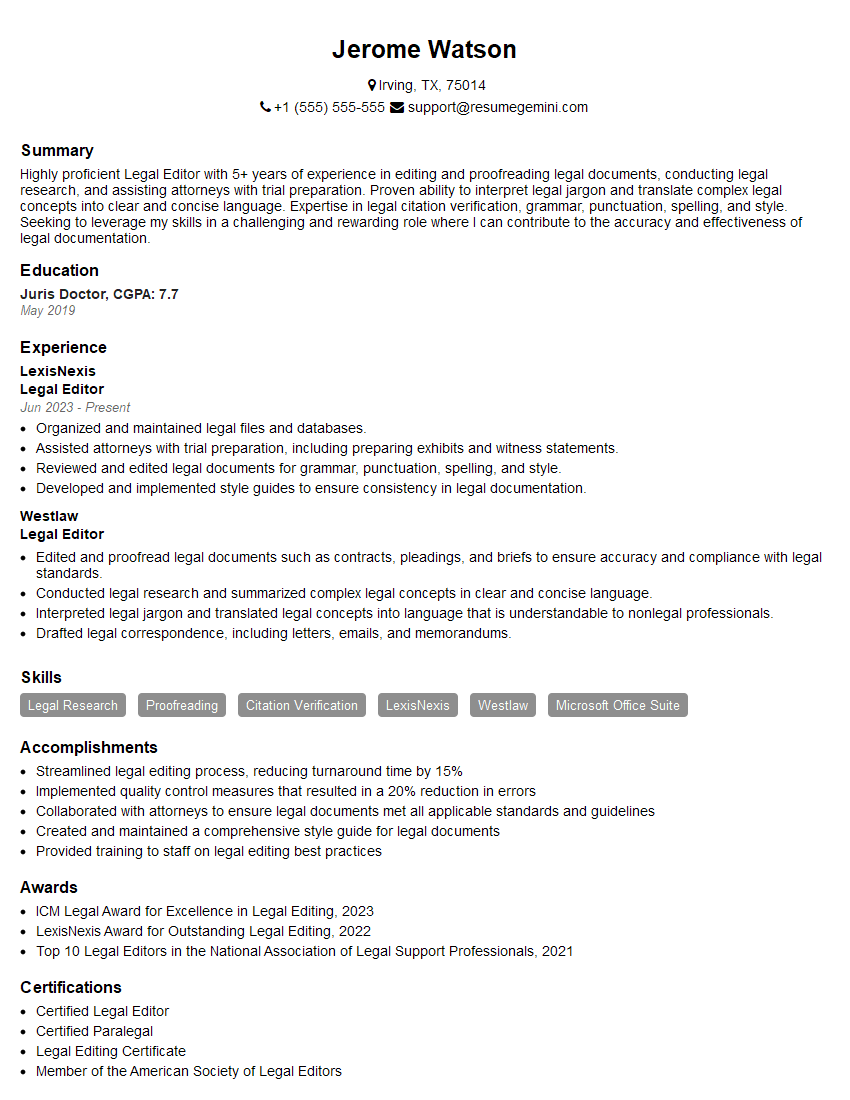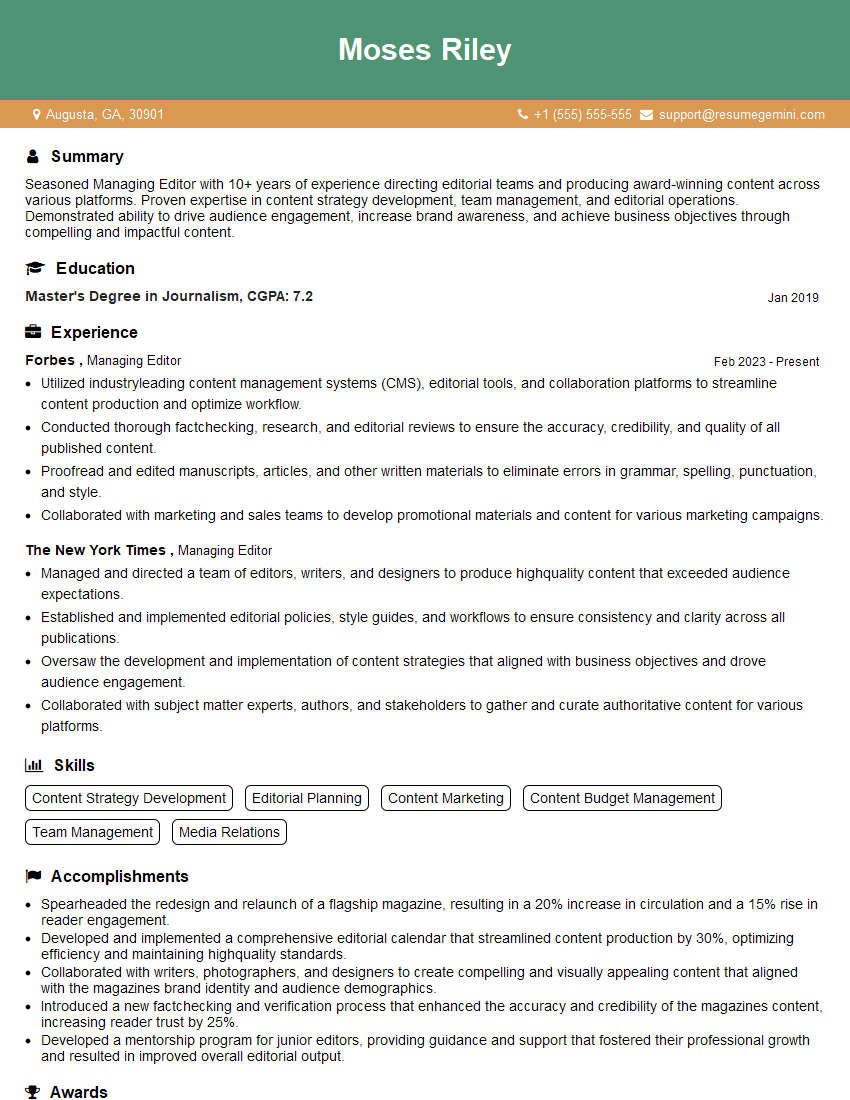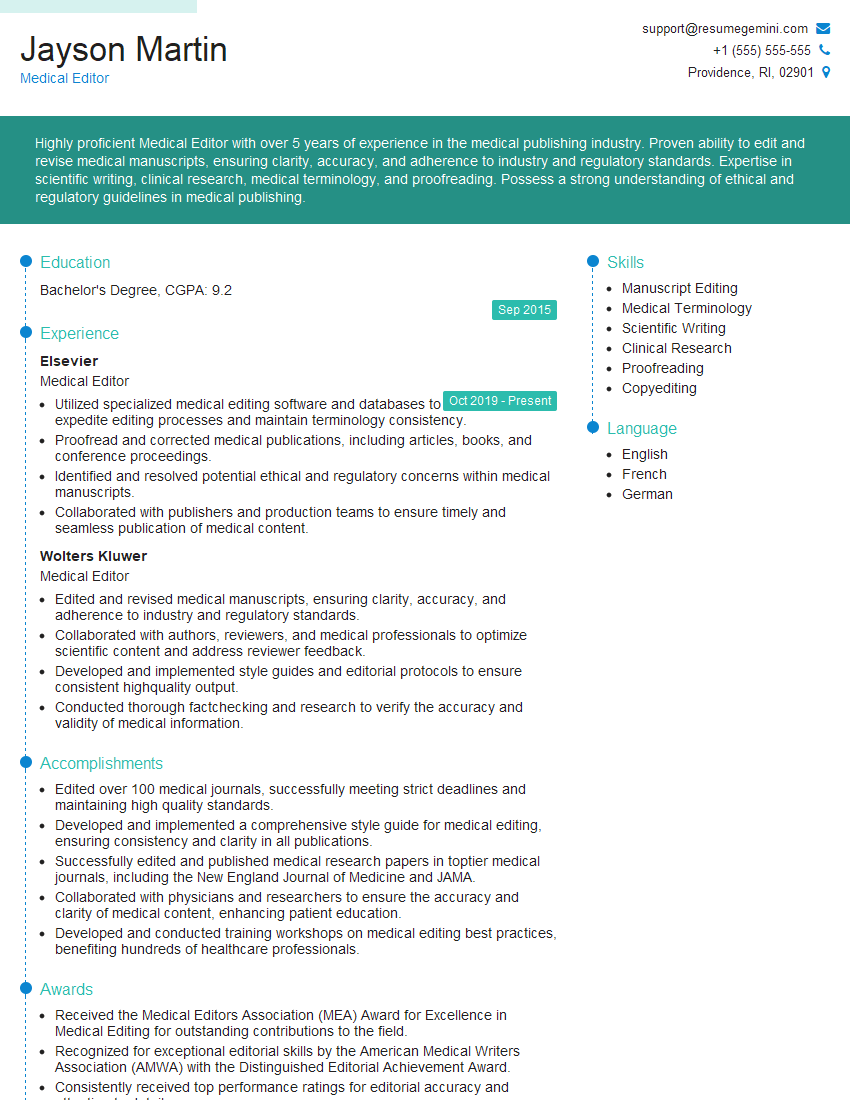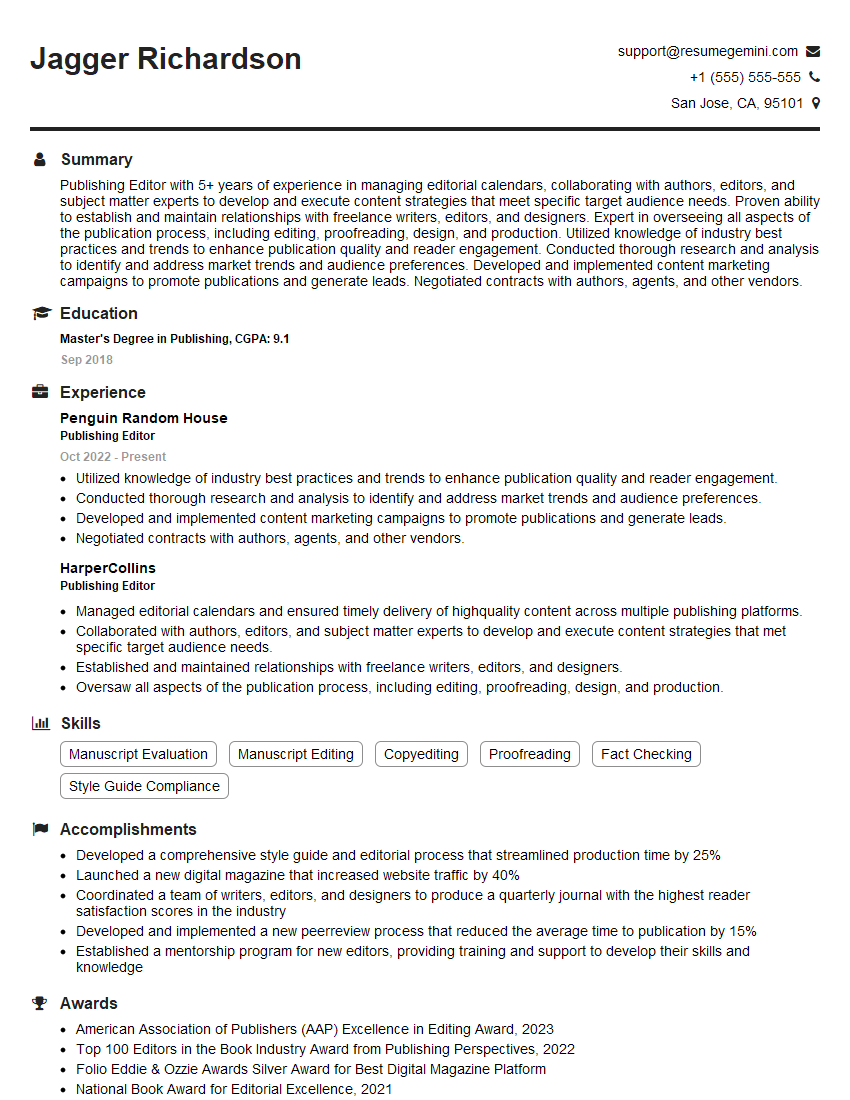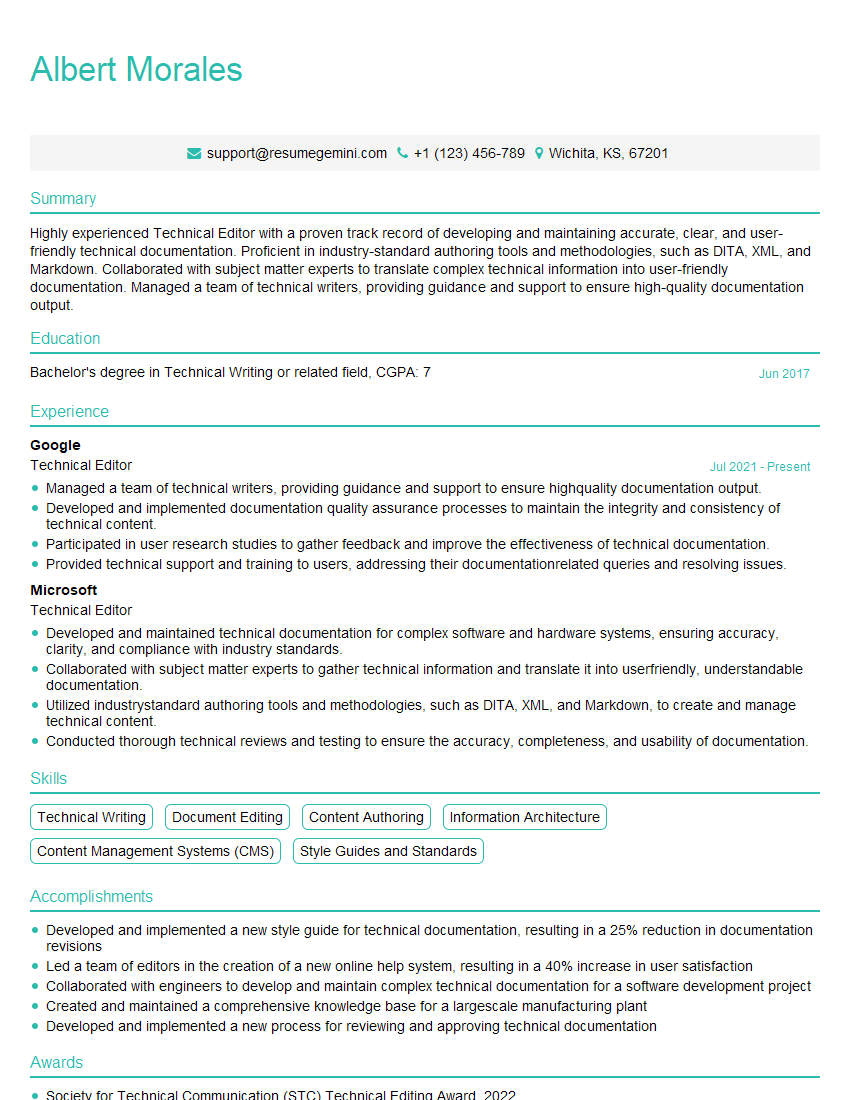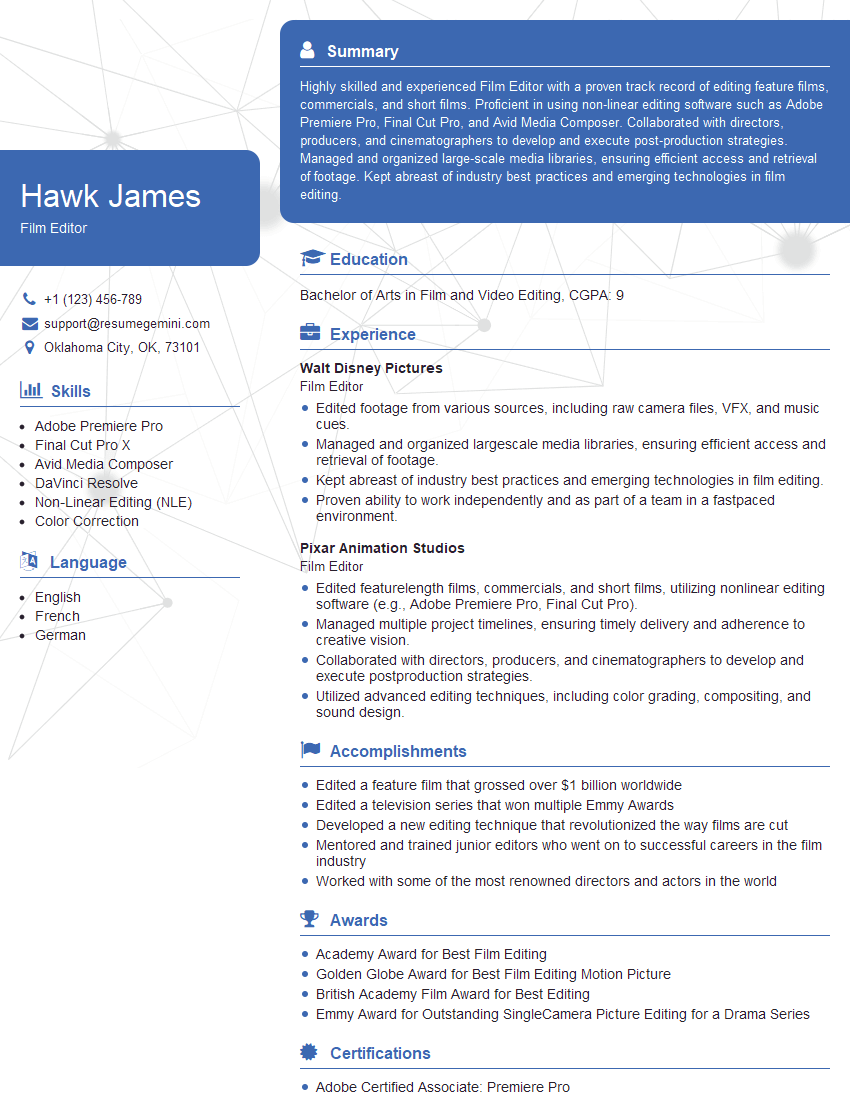The right preparation can turn an interview into an opportunity to showcase your expertise. This guide to Reviewing and Editing Creative Content interview questions is your ultimate resource, providing key insights and tips to help you ace your responses and stand out as a top candidate.
Questions Asked in Reviewing and Editing Creative Content Interview
Q 1. Explain the difference between copyediting and proofreading.
Copyediting and proofreading are both crucial stages in the content creation process, but they focus on different aspects. Think of it like building a house: copyediting is the construction, while proofreading is the final inspection.
Copyediting is a more comprehensive process that involves checking for style, consistency, clarity, accuracy, and overall readability. A copyeditor might restructure sentences, suggest better word choices, ensure consistent voice and tone, and verify facts. They’re concerned with the overall quality and impact of the writing.
Proofreading, on the other hand, is the final check for typos, grammatical errors, spelling mistakes, and inconsistencies in formatting. It’s a meticulous search for surface-level errors after the substantial editing is complete. A proofreader focuses on the visual presentation of the text, ensuring it is error-free before publication.
Example: A copyeditor might change “The cat sat on the mat” to “The feline gracefully reclined upon the rug” to improve style and tone. A proofreader would then check for any typos in the revised sentence.
Q 2. Describe your process for reviewing a long-form article.
My process for reviewing a long-form article involves several stages, ensuring a thorough and systematic approach. It’s like assembling a complex puzzle – each piece contributes to the final picture.
- First Read: I read the article for overall flow, understanding the main points, and identifying any major structural issues. This is a big-picture assessment.
- Second Read (Focused): I focus on specific elements – grammar, style, consistency, and factual accuracy. I use a style guide (depending on the client’s preference) to ensure consistency.
- Fact-Checking: For any claims or statistics, I verify their accuracy using reliable sources. This is critical for maintaining credibility.
- Style and Tone Consistency: I check for consistency in voice, tone, and style throughout the entire article. This creates a unified and professional read.
- Structural Edits: I suggest changes to improve the flow, organization, and clarity of the article, including headings, subheadings, and transitions.
- Final Read (Proofreading): This is my final check for any remaining errors in spelling, grammar, punctuation, and formatting. I use a clean copy for this final review to catch any errors I may have missed earlier.
- Feedback and Collaboration: I provide detailed feedback to the author, explaining my edits and suggestions clearly. I am always open to discussion and collaboration.
Q 3. How do you handle conflicting feedback from multiple stakeholders?
Handling conflicting feedback from multiple stakeholders requires diplomacy, clear communication, and a prioritization strategy. It’s about finding consensus, not just satisfying everyone.
My approach involves:
- Understanding the Perspectives: I carefully review each piece of feedback, trying to understand the rationale behind it. What are their specific concerns? What are they hoping to achieve?
- Identifying Common Ground: I search for areas of agreement between the stakeholders’ feedback. This helps to build a foundation for resolution.
- Prioritization and Justification: I prioritize feedback based on its impact on the overall quality and effectiveness of the content, considering factors such as audience, brand voice, and objectives. I explain my decisions clearly, justifying them with reference to best practices and industry standards.
- Mediation and Collaboration: If necessary, I facilitate a discussion between stakeholders to help them reach a common understanding and resolution. Sometimes, I need to help them see the bigger picture.
- Documentation: I keep detailed records of all feedback received, my rationale for the decisions I make, and the final changes implemented. This is crucial for transparency and accountability.
Example: If one stakeholder wants a more formal tone while another wants a more casual approach, I might suggest a compromise – a slightly less formal tone than originally proposed to maintain professionalism while still engaging the intended audience.
Q 4. What style guides are you familiar with (e.g., AP, Chicago)?
I am proficient in several style guides, adapting my approach depending on the client’s requirements. The choice of style guide is critical for consistency and professional presentation.
- AP Stylebook (Associated Press): Primarily used for journalism and news writing, it emphasizes conciseness and clarity.
- Chicago Manual of Style: A comprehensive guide used in academia and scholarly publishing, emphasizing precision and detail.
- MLA Handbook (Modern Language Association): Primarily used in humanities and literature, it focuses on proper citation and referencing.
I also have experience with other style guides, and I am a quick study when presented with a new one. My adaptability is a key strength.
Q 5. How do you identify and correct grammatical errors and inconsistencies?
Identifying and correcting grammatical errors and inconsistencies requires a keen eye for detail and a strong understanding of grammar rules. It’s like being a detective, tracing the clues to solve the grammatical puzzle.
My approach involves:
- Careful Reading: I read the text carefully, paying close attention to sentence structure, punctuation, verb tense, subject-verb agreement, and pronoun usage.
- Grammar and Style Checkers: While I don’t rely solely on these tools, I utilize grammar and style checkers (like Grammarly) as an initial screening tool to catch obvious errors.
- Reference Materials: I frequently consult grammar and style guides to clarify any ambiguities or confirm my corrections.
- Consistent Application: I ensure that all grammatical conventions are applied consistently throughout the document.
Example: If I find a sentence with a subject-verb disagreement, like “The dogs chases the ball,” I will correct it to “The dogs chase the ball.”
Q 6. How do you ensure clarity, consistency, and accuracy in your edits?
Ensuring clarity, consistency, and accuracy in my edits is paramount. It’s all about refining the text to achieve optimal communication. It’s like sculpting a piece of art – refining and polishing until it shines.
I achieve this through:
- Active Voice and Concise Language: I favor active voice and concise language to make the writing clear and direct, avoiding jargon and overly complex sentence structures.
- Consistent Tone and Style: I maintain consistency in tone, style, and terminology throughout the document to create a unified and professional voice.
- Accurate Fact-Checking: I verify all facts and figures using reliable sources to ensure accuracy and credibility.
- Multiple Reads: I review the edited document multiple times, each time with a different focus, to catch errors and improve the overall quality.
- Feedback and Iteration: I collaborate with authors to incorporate feedback and refine the document until it meets the highest standards.
Q 7. Describe your experience with content management systems (CMS).
I possess extensive experience working with various Content Management Systems (CMS), including WordPress, Drupal, and Contentful. My familiarity extends beyond basic content input; I understand how CMS architectures affect content structure and workflows.
My experience encompasses:
- Content Creation and Editing within CMS Platforms: I’m comfortable creating and editing content directly within the CMS environment, understanding the limitations and possibilities of each platform.
- Workflow Optimization: I’m familiar with content workflows within CMS and can suggest improvements to optimize the process for efficiency.
- Technical Knowledge: While not a developer, I understand the basics of HTML, CSS, and other web technologies to ensure content is properly formatted and displays correctly.
- SEO Optimization: I’m aware of best practices for SEO optimization within CMS platforms, contributing to the overall success of the content.
For example, I’m proficient in using WordPress’s custom fields to maintain consistency across multiple posts or creating custom taxonomies for better organization.
Q 8. How do you prioritize tasks when facing tight deadlines?
Prioritizing tasks under tight deadlines requires a strategic approach. I utilize a combination of techniques, starting with a clear understanding of project goals and deadlines. Then, I employ a prioritization framework like the Eisenhower Matrix (urgent/important), assigning tasks to quadrants based on their urgency and importance.
For example, if I have multiple editing projects due, I’d prioritize those closest to their deadlines and with the highest impact (e.g., a key marketing campaign piece trumps a minor blog post). I break down large tasks into smaller, manageable chunks to improve focus and track progress effectively. This allows for better time allocation and minimizes the risk of missing deadlines. Regularly checking my progress against the schedule and adapting to any unforeseen issues is crucial. Tools like project management software can aid in this process immensely, allowing for task delegation and visualization of the workflow.
Q 9. What are some common mistakes you see in creative content?
Common mistakes I encounter in creative content often boil down to inconsistencies and a lack of attention to detail. These include:
- Inconsistent brand voice and tone: The messaging doesn’t align with the established brand identity, creating a confusing experience for the audience.
- Poor grammar and punctuation: These errors significantly detract from the credibility and professionalism of the content.
- Lack of clarity and conciseness: Rambling sentences, unnecessary jargon, and convoluted structures make it difficult for readers to understand the message.
- Weak calls to action (CTAs): The content fails to effectively guide readers towards the desired outcome.
- Inadequate fact-checking and verification: Inaccurate information undermines the credibility of the brand and can even lead to legal issues.
- Poor SEO optimization: Content that isn’t optimized for search engines has a reduced reach and impact.
For instance, I recently edited a piece where the brand voice shifted abruptly between formal and informal language, creating a jarring reading experience. Addressing such inconsistencies requires a careful review and consistent application of style guidelines.
Q 10. How do you maintain consistency in brand voice and tone across various platforms?
Maintaining brand consistency across platforms requires a meticulous approach. First, I ensure I have access to and thoroughly understand the brand’s style guide, which should outline the preferred voice, tone, and vocabulary. I use this as a constant reference point throughout the editing process.
For example, if the brand voice is playful and informal on social media, but more formal and professional on the company website, the content needs to be tailored accordingly. I create checklists and templates based on the style guide to ensure consistency across different platforms and content types. I also collaborate closely with the marketing and communications team to ensure that everyone is on the same page and using the same language.
Furthermore, utilizing consistent templates and brand assets (logos, fonts, colors) across all platforms reinforces brand identity. Regular review and updates to the style guide are also crucial for adaptation to evolving brand messaging.
Q 11. Describe your experience with fact-checking and verification.
Fact-checking and verification are critical components of my editing process. My approach is multi-layered. I start by verifying the claims within the content using multiple reputable sources. I cross-reference information from different sources to ensure accuracy. I pay close attention to dates, statistics, and proper attribution. I use fact-checking tools and databases to verify facts and figures.
For example, if an article claims a specific statistic, I would search for reliable sources supporting this claim, ensuring it is not outdated or misinterpreted. I then carefully review the source material to determine its credibility, looking for potential bias or conflicts of interest. If discrepancies or uncertainties arise, I flag them for the writer or content creator to address.
In cases of sensitive information or complex topics, I may consult subject matter experts for verification. Documentation of my fact-checking process is essential, allowing for traceability and accountability.
Q 12. How do you handle edits on complex documents with multiple contributors?
Managing edits on complex documents with multiple contributors necessitates a well-organized and collaborative approach. I utilize version control software, such as Google Docs or Microsoft Word’s track changes feature. This allows me to track edits made by each contributor, enabling easy comparison and conflict resolution.
Furthermore, I establish clear communication channels, using comments and annotations to provide specific feedback directly within the document. Regular check-ins with contributors ensure alignment and minimize misunderstandings. I also create a clear style guide and editorial guidelines to help maintain consistency throughout the document.
A consolidated feedback session with all contributors helps address conflicting viewpoints or inconsistencies. Prioritizing clear communication and utilizing efficient collaboration tools is essential for effectively handling complex, multi-contributor documents.
Q 13. How do you provide constructive feedback to writers?
Providing constructive feedback to writers requires tact and empathy. My approach focuses on being specific, actionable, and encouraging. I avoid general criticisms and instead pinpoint specific areas for improvement, offering suggestions for revision.
For example, instead of saying “This section is confusing,” I would say, “The transition between paragraphs 3 and 4 is abrupt. Consider adding a sentence to connect these ideas more smoothly.” I always frame my feedback positively, emphasizing the strengths of the writing while addressing areas needing enhancement. I might say something like: “The imagery in this piece is captivating; however, consider tightening up the introduction to make it more concise.”
I encourage dialogue and collaboration, inviting the writer to discuss my suggestions and explore alternative solutions. My aim is to empower writers, fostering their growth and improving their writing skills. Building a positive and collaborative relationship is key to effective feedback.
Q 14. Explain your understanding of SEO best practices in content editing.
My understanding of SEO best practices in content editing encompasses both on-page and off-page optimization. On-page optimization involves optimizing the content itself to improve its ranking in search engine results pages (SERPs). This includes using relevant keywords naturally throughout the text, optimizing title tags and meta descriptions, and ensuring the content is well-structured and easy to read.
Off-page optimization focuses on external factors that influence a website’s ranking, such as backlinks from high-authority websites. While I don’t directly control off-page factors, my edits can improve a page’s overall quality and attractiveness, indirectly increasing its chances of earning high-quality backlinks. I also consider factors like readability, mobile-friendliness, and page speed, which all impact SEO.
For instance, I ensure that keyword density is optimized to avoid keyword stuffing while remaining relevant to the target audience. I also focus on creating high-quality, informative content that is likely to be shared and linked to naturally, improving the website’s authority and search engine ranking.
Q 15. How do you adapt your editing style to different target audiences?
Adapting my editing style to different target audiences is crucial for effective communication. It’s not just about grammar and spelling; it’s about understanding the audience’s background, interests, and the level of formality they expect. I approach this by first analyzing the intended audience. For instance, a blog post targeting teenagers will use a much different tone and vocabulary than a white paper for scientific professionals.
- Tone and Style: For teenagers, I might use informal language, slang (appropriately), and shorter sentences. For academics, a formal, precise tone with complex sentence structures is needed.
- Vocabulary: I adjust the complexity of the vocabulary. Simple terms are preferred for younger or less informed audiences, while specialized jargon might be acceptable (and even expected) for experts.
- Content Focus: I emphasize different aspects based on the audience. Teenagers might respond to a narrative approach, while a scientific audience needs evidence-based arguments and citations.
Essentially, I tailor the writing to resonate with the target audience, ensuring clarity, engagement, and relevance.
Career Expert Tips:
- Ace those interviews! Prepare effectively by reviewing the Top 50 Most Common Interview Questions on ResumeGemini.
- Navigate your job search with confidence! Explore a wide range of Career Tips on ResumeGemini. Learn about common challenges and recommendations to overcome them.
- Craft the perfect resume! Master the Art of Resume Writing with ResumeGemini’s guide. Showcase your unique qualifications and achievements effectively.
- Don’t miss out on holiday savings! Build your dream resume with ResumeGemini’s ATS optimized templates.
Q 16. Describe your experience with different content formats (blog posts, articles, website copy).
My experience spans a wide range of content formats, including blog posts, articles, website copy, marketing materials, and even scripts. I’m comfortable with the specific requirements of each.
- Blog Posts: These require a conversational, engaging style, often incorporating multimedia elements. The focus is on creating a quick, easy read that keeps the reader hooked.
- Articles: Articles, depending on the publication, may necessitate a more formal tone and in-depth analysis. They usually require fact-checking, rigorous editing, and adherence to specific style guides.
- Website Copy: Website copy focuses on clarity and conversion. The text needs to be concise, persuasive, and easily scannable, leading the reader towards a specific action (e.g., making a purchase).
I’ve found that understanding the purpose of each format – the ‘why’ behind the writing – is key to successful editing. For instance, a blog post aims for engagement, while website copy aims for action. This understanding informs my editing decisions throughout the process.
Q 17. How do you use editing tools to improve efficiency and accuracy?
I leverage various editing tools to enhance efficiency and accuracy. My workflow incorporates tools like Grammarly, ProWritingAid, and Hemingway Editor for grammar, style, and readability checks. These tools help flag potential errors I might miss, allowing for a faster and more thorough review. Beyond these, I use:
- Style Guides (e.g., Chicago Manual of Style, AP Stylebook): Ensuring consistency and accuracy.
- MS Word’s Track Changes: Facilitating collaboration and providing clear feedback to writers.
- Version Control Systems (e.g., Git): For managing different revisions of the content.
These tools aren’t replacements for human judgment; they are powerful aids. I always review the suggestions offered by these tools critically and use my editorial expertise to make the final decisions. I consider them indispensable for ensuring accuracy and consistency.
Q 18. What resources do you use to stay up-to-date on grammar and style rules?
Staying current on grammar and style rules is essential. I rely on a combination of resources to ensure I’m always up-to-date:
- Style Manuals: The Chicago Manual of Style and the AP Stylebook are my go-to references for grammar, punctuation, and style conventions.
- Online Resources: Websites like Grammarly’s blog, Purdue OWL (Online Writing Lab), and the Merriam-Webster dictionary offer valuable insights and updates on language usage.
- Professional Development: I regularly attend workshops and webinars focused on editing and publishing to stay abreast of evolving best practices.
- Peer Review: Participating in peer review sessions within my professional networks helps to share knowledge and improve my understanding.
Continuous learning is a crucial part of my job as an editor, enabling me to maintain high standards of accuracy and professionalism.
Q 19. Describe a time you had to significantly revise a poorly written piece of content.
I once received a marketing article that was riddled with grammatical errors, inconsistent tone, and lacked a clear structure. The original piece was essentially a jumbled mess of ideas. My revision involved a multi-step process:
- Deconstruction: I first broke down the piece into its core components – identifying the main points, target audience, and desired outcome.
- Rewriting: Based on my analysis, I completely rewrote significant portions, simplifying complex sentences, and ensuring a consistent tone. I focused on making the text clear, concise, and persuasive.
- Restructuring: I reorganized the information into a logical flow, using headings and subheadings to enhance readability.
- Fact-Checking: I verified all the information to guarantee accuracy.
- Style Consistency: I applied a consistent style guide (the AP Stylebook in this instance) throughout the revised piece.
The final result was a polished, professional piece that effectively communicated the marketing message. This experience highlighted the importance of careful planning, and structural revision, in addition to correcting surface-level errors.
Q 20. How do you identify and resolve plagiarism issues?
Identifying and resolving plagiarism is critical to maintaining ethical standards. My approach involves a multi-pronged strategy:
- Plagiarism Detection Software: I utilize tools such as Turnitin or Copyscape to scan the content for similarities with existing publications.
- Manual Review: While software is helpful, I always conduct a manual review. I look for unusual phrasing, overly specialized language, or inconsistencies in style that might indicate plagiarism. I also cross-reference citations if any are provided.
- Source Verification: If plagiarism is suspected, I meticulously investigate the source material to determine the extent of the issue.
- Collaboration: I discuss the plagiarism issue with the writer, addressing the problem openly and collaboratively.
The goal is not just to identify plagiarism, but to understand why it occurred and work with the writer to create original, ethical content. Depending on the severity of the issue, I may recommend significant revisions or even reject the work.
Q 21. How familiar are you with accessibility guidelines for digital content?
I am familiar with accessibility guidelines for digital content, particularly WCAG (Web Content Accessibility Guidelines). This involves understanding how to create content that is usable by people with disabilities. My understanding encompasses various aspects, including:
- Alternative Text for Images: Providing descriptive alt text for all images to ensure screen readers can convey the image’s meaning to visually impaired users.
- Captioning and Transcriptions: Ensuring videos and audio content have captions and transcripts for hearing-impaired users.
- Keyboard Navigation: Making sure the content is fully navigable using only a keyboard, crucial for users with motor impairments.
- Color Contrast: Using sufficient color contrast between text and background to make it easily readable for users with visual impairments.
- Structure and Headings: Using proper heading levels (H1, H2, etc.) to create a logical structure for screen readers to follow.
I believe accessible content benefits everyone, creating a more inclusive online experience. I incorporate these principles into my editing process to ensure the content meets accessibility standards.
Q 22. Describe your experience working with diverse teams and perspectives.
Throughout my career, I’ve collaborated extensively with diverse teams, including writers, designers, marketers, and developers from various cultural backgrounds and professional experiences. This collaborative spirit is crucial in creative content editing, where a variety of viewpoints enrich the final product. For instance, on a recent project involving a global marketing campaign, I worked with a team spanning three continents. Our differing perspectives – on cultural nuances, target audience preferences, and even the best use of visual metaphors – led to a richer and more impactful final campaign than any single individual could have achieved alone. I’m adept at navigating differing opinions, fostering inclusive discussions, and finding common ground to ensure a cohesive and effective outcome. Active listening and a genuine interest in others’ viewpoints are key components of my collaborative approach.
Q 23. What are your strengths and weaknesses as a content editor?
My greatest strengths as a content editor lie in my keen eye for detail, my ability to maintain consistency across large volumes of content, and my strong understanding of grammar and style. I excel at transforming complex or unclear writing into clear, concise, and engaging narratives. I also possess a deep understanding of SEO best practices, which enables me to optimize content for search engines while maintaining a natural and readable style. One area where I’m constantly working on improvement is speed. While I maintain high standards of quality, I’m striving to improve my workflow efficiency to meet tighter deadlines without sacrificing the quality of my edits. To address this, I’m exploring new technologies and software designed to streamline the editing process.
Q 24. How do you ensure the accuracy and reliability of sources used in your edits?
Accuracy and reliability of sources are paramount. My process begins with verifying the credibility of each source. I check the author’s credentials, the publication’s reputation, and the date of publication. For academic sources, I cross-reference information with multiple reputable sources to avoid relying on a single potentially biased viewpoint. If a source is questionable, I flag it for further investigation or suggest alternative sources to the content creator. I meticulously document all sources, following a consistent citation style appropriate for the content (e.g., APA, MLA, Chicago). This detailed approach ensures transparency and allows for easy verification of information. Imagine a medical article – the consequences of using unreliable information are severe. My rigorous source verification process mitigates these risks.
Q 25. Describe your understanding of copyright laws and their implications for content.
Copyright law is central to my work. I understand the importance of obtaining permissions for copyrighted material, including images, text, and music. I’m familiar with fair use principles, understanding the limitations and nuances of utilizing copyrighted work without permission. My approach involves proactively identifying potentially copyrighted material and either securing the necessary permissions or finding alternative, royalty-free content. I also educate content creators on copyright best practices, helping them avoid infringement and legal complications. Ignoring copyright laws can lead to significant legal and financial penalties; therefore, understanding and respecting them is essential.
Q 26. How do you handle sensitive or controversial topics in content editing?
Handling sensitive or controversial topics requires a nuanced approach. My primary goal is to ensure that the content is presented responsibly and ethically. This involves careful consideration of the language used, ensuring it’s both accurate and avoids inflammatory rhetoric. I also consider the potential impact of the content on different audiences and strive for neutrality and objectivity. When dealing with highly sensitive subject matter, I often consult with subject matter experts or colleagues to ensure accuracy and avoid misrepresentation. The key is to balance informing the reader with sensitivity and responsibility. For example, in editing a piece on a sensitive social issue, I’d focus on presenting facts and various perspectives while avoiding language that could be perceived as biased or offensive.
Q 27. How do you measure the effectiveness of your editing work?
Measuring the effectiveness of my editing work is multifaceted. Immediately after an editing project, I evaluate its clarity, consistency, and accuracy. Longer-term effectiveness is assessed through various metrics such as engagement rates (likes, shares, comments), website traffic, and conversion rates (if applicable). For example, improved website bounce rate following edits indicates improved readability and user experience. Client feedback is also crucial; direct positive feedback from clients validating the improved quality and impact of the edited content is a key indicator of success. The ultimate measure is whether the edited content achieved its intended goals, such as increasing brand awareness or driving sales.
Q 28. What are your salary expectations for this role?
My salary expectations for this role are between [Insert Salary Range] annually. This is based on my experience, skills, and the responsibilities associated with this position. I’m open to discussing this further based on the specifics of the role and the overall compensation package.
Key Topics to Learn for Reviewing and Editing Creative Content Interview
- Understanding the Creative Brief: Deconstructing the client’s vision and identifying key objectives for the creative piece.
- Grammar, Mechanics, and Style: Applying consistent grammatical rules, punctuation, and style guides to ensure clarity and professionalism. Practical application: Identifying and correcting errors in various content formats (blog posts, website copy, social media captions).
- Brand Voice and Tone: Maintaining consistency in brand messaging across all platforms. Practical application: Assessing whether content accurately reflects the intended brand personality.
- Fact-Checking and Verification: Ensuring accuracy and credibility of information presented in the creative content. Practical application: Developing strategies for efficiently verifying information from multiple sources.
- Clarity and Conciseness: Streamlining language for optimal readability and impact. Practical application: Identifying and removing jargon, clichés, and unnecessary words.
- SEO Optimization (where applicable): Understanding keyword research and implementation to improve content visibility. Practical application: Suggesting relevant keywords and assessing their natural integration within the content.
- Structural Editing: Improving the overall organization and flow of the content. Practical application: Suggesting improvements to paragraph structure, headings, and transitions.
- Providing Constructive Feedback: Offering clear, actionable, and positive suggestions for improvement. Practical application: Developing effective communication strategies for collaborating with writers and creative teams.
- Understanding Copyright and Legal Considerations: Awareness of copyright laws and ethical considerations related to content creation and usage.
Next Steps
Mastering reviewing and editing creative content significantly enhances your career prospects, opening doors to diverse roles in marketing, publishing, advertising, and content creation. An ATS-friendly resume is crucial for getting your application noticed by recruiters. To build a compelling and effective resume that highlights your skills and experience, we strongly encourage you to utilize ResumeGemini. ResumeGemini offers a streamlined process and provides examples of resumes tailored specifically to Reviewing and Editing Creative Content, helping you showcase your qualifications effectively and land your dream job.
Explore more articles
Users Rating of Our Blogs
Share Your Experience
We value your feedback! Please rate our content and share your thoughts (optional).
What Readers Say About Our Blog
Hi, I’m Jay, we have a few potential clients that are interested in your services, thought you might be a good fit. I’d love to talk about the details, when do you have time to talk?
Best,
Jay
Founder | CEO

